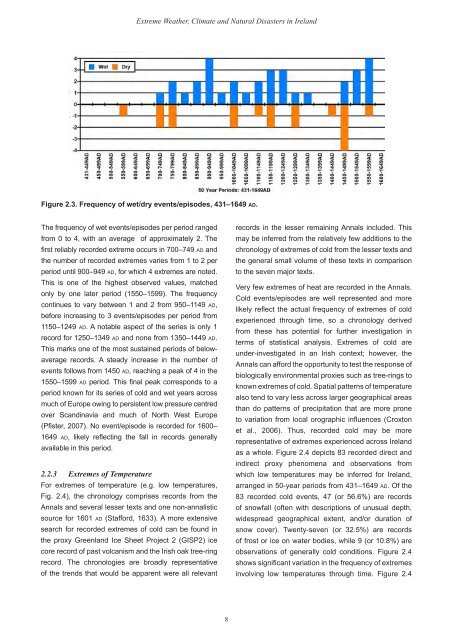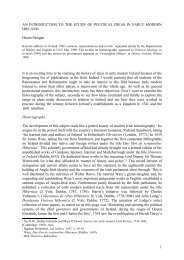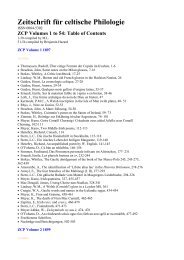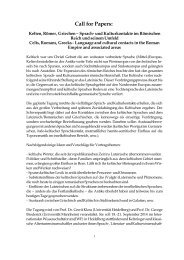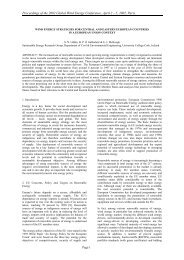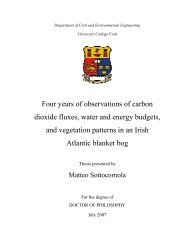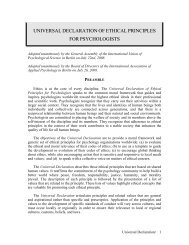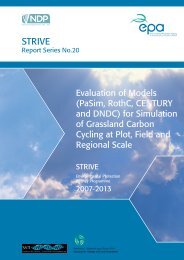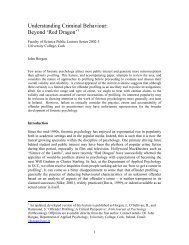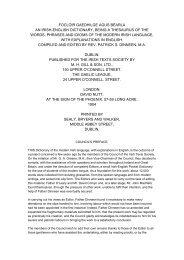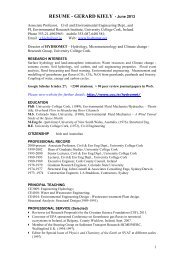Extreme Weather, Climate and Natural Disasters in Ireland
Extreme Weather, Climate and Natural Disasters in Ireland
Extreme Weather, Climate and Natural Disasters in Ireland
You also want an ePaper? Increase the reach of your titles
YUMPU automatically turns print PDFs into web optimized ePapers that Google loves.
<strong>Extreme</strong> <strong>Weather</strong>, <strong>Climate</strong> <strong>and</strong> <strong>Natural</strong> <strong>Disasters</strong> <strong>in</strong> Irel<strong>and</strong><br />
Figure 2.3. Frequency of wet/dry events/episodes, 431–1649 ad.<br />
The frequency of wet events/episodes per period ranged<br />
from 0 to 4, with an average of approximately 2. The<br />
first reliably recorded extreme occurs <strong>in</strong> 700–749 ad <strong>and</strong><br />
the number of recorded extremes varies from 1 to 2 per<br />
period until 900–949 ad, for which 4 extremes are noted.<br />
This is one of the highest observed values, matched<br />
only by one later period (1550–1599). The frequency<br />
cont<strong>in</strong>ues to vary between 1 <strong>and</strong> 2 from 950–1149 ad,<br />
before <strong>in</strong>creas<strong>in</strong>g to 3 events/episodes per period from<br />
1150–1249 ad. A notable aspect of the series is only 1<br />
record for 1250–1349 ad <strong>and</strong> none from 1350–1449 ad.<br />
This marks one of the most susta<strong>in</strong>ed periods of belowaverage<br />
records. A steady <strong>in</strong>crease <strong>in</strong> the number of<br />
events follows from 1450 ad, reach<strong>in</strong>g a peak of 4 <strong>in</strong> the<br />
1550–1599 ad period. This f<strong>in</strong>al peak corresponds to a<br />
period known for its series of cold <strong>and</strong> wet years across<br />
much of Europe ow<strong>in</strong>g to persistent low pressure centred<br />
over Sc<strong>and</strong><strong>in</strong>avia <strong>and</strong> much of North West Europe<br />
(Pfister, 2007). No event/episode is recorded for 1600–<br />
1649 ad, likely reflect<strong>in</strong>g the fall <strong>in</strong> records generally<br />
available <strong>in</strong> this period.<br />
2.2.3 <strong>Extreme</strong>s of Temperature<br />
For extremes of temperature (e.g. low temperatures,<br />
Fig. 2.4), the chronology comprises records from the<br />
Annals <strong>and</strong> several lesser texts <strong>and</strong> one non-annalistic<br />
source for 1601 ad (Stafford, 1633). A more extensive<br />
search for recorded extremes of cold can be found <strong>in</strong><br />
the proxy Greenl<strong>and</strong> Ice Sheet Project 2 (GISP2) ice<br />
core record of past volcanism <strong>and</strong> the Irish oak tree-r<strong>in</strong>g<br />
record. The chronologies are broadly representative<br />
of the trends that would be apparent were all relevant<br />
records <strong>in</strong> the lesser rema<strong>in</strong><strong>in</strong>g Annals <strong>in</strong>cluded. This<br />
may be <strong>in</strong>ferred from the relatively few additions to the<br />
chronology of extremes of cold from the lesser texts <strong>and</strong><br />
the general small volume of these texts <strong>in</strong> comparison<br />
to the seven major texts.<br />
Very few extremes of heat are recorded <strong>in</strong> the Annals.<br />
Cold events/episodes are well represented <strong>and</strong> more<br />
likely reflect the actual frequency of extremes of cold<br />
experienced through time, so a chronology derived<br />
from these has potential for further <strong>in</strong>vestigation <strong>in</strong><br />
terms of statistical analysis. <strong>Extreme</strong>s of cold are<br />
under-<strong>in</strong>vestigated <strong>in</strong> an Irish context; however, the<br />
Annals can afford the opportunity to test the response of<br />
biologically environmental proxies such as tree-r<strong>in</strong>gs to<br />
known extremes of cold. Spatial patterns of temperature<br />
also tend to vary less across larger geographical areas<br />
than do patterns of precipitation that are more prone<br />
to variation from local orographic <strong>in</strong>fluences (Croxton<br />
et al., 2006). Thus, recorded cold may be more<br />
representative of extremes experienced across Irel<strong>and</strong><br />
as a whole. Figure 2.4 depicts 83 recorded direct <strong>and</strong><br />
<strong>in</strong>direct proxy phenomena <strong>and</strong> observations from<br />
which low temperatures may be <strong>in</strong>ferred for Irel<strong>and</strong>,<br />
arranged <strong>in</strong> 50-year periods from 431–1649 ad. Of the<br />
83 recorded cold events, 47 (or 56.6%) are records<br />
of snowfall (often with descriptions of unusual depth,<br />
widespread geographical extent, <strong>and</strong>/or duration of<br />
snow cover). Twenty-seven (or 32.5%) are records<br />
of frost or ice on water bodies, while 9 (or 10.8%) are<br />
observations of generally cold conditions. Figure 2.4<br />
shows significant variation <strong>in</strong> the frequency of extremes<br />
<strong>in</strong>volv<strong>in</strong>g low temperatures through time. Figure 2.4<br />
8


